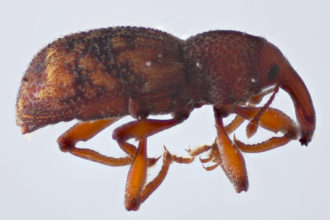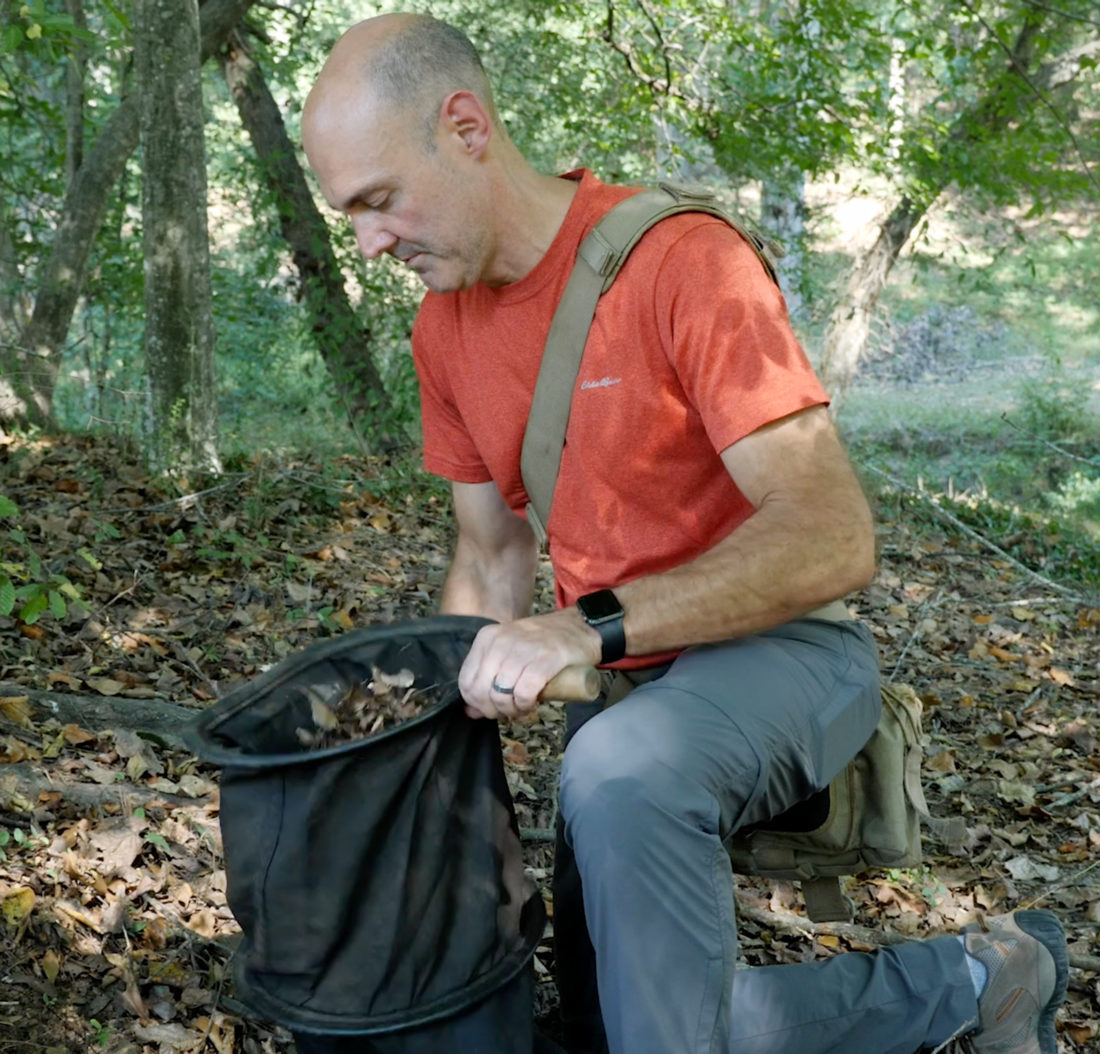By the early 19th century, the South may have been part of the United States, but it remained a frontier of the unknown for naturalists such as John James Audubon. On adventures to territories that included Kentucky, Mississippi and Alabama, the ornithologist and painter found 25 previously undiscovered species and 12 subspecies of birds.
For Paul Marek, an assistant professor of entomology at Virginia Tech, the region is still ripe for exploration. Instead of turning to the sky, however, his eyes are fixed firmly on the ground.
“With millipedes, we’re pretty much where we were with birds in the 1800s,” Marek explains. “We have a decent idea about overall diversity, but we’re still discovering species.”
Together with Michael Caterino, director of the Clemson University Arthropod Collection, Marek is embarking in November on a three-year project to catalog the diversity of litter-dwelling arthropods — the biological group that includes such creatures as millipedes, spiders and beetles — on the high mountain peaks of the Southern Appalachians. The two plan to survey Western North Carolina landmarks like Mount Mitchell and Grandfather Mountain as part of their research.
Much of the scientific community’s recent study on arthropods, Caterino notes, has focused on the tropics, “where new species are still a dime a dozen.” But he and Marek are more interested in the novelties to be found in their own backyards, and the collaborators were recently awarded more than $700,000 from the National Science Foundation to conduct their work.
“I think there’s a sense that in North America and in Europe and in other parts of the temperate world, where we’ve been doing entomology and researching for a long time, that things are pretty well known already,” Caterino says. “And there are these little pockets where that’s not true.”
Into the woods
The project will focus on arthropods living in the litter — fallen leaves, twigs and needles and other dead vegetation — beneath Appalachia’s spruce-fir forests, which exist only as “sky islands” at elevations above about 5,000 feet. These rare ecosystems, Caterino says, are cooler and moister than surrounding areas and can support species that don’t live anywhere else.

The researchers will hike to these locations, collect samples from the forest floor and sift out any arthropods lurking in the litter. Using DNA barcoding, a technique that compares differences between similar short sections of genetic material, Caterino and Marek will determine what creatures live where and identify species that don’t fit into existing scientific classifications.
“We don’t even know what’s up there,” Marek says. “We’re not going to be able to properly address management and conservation without knowing what’s there, so that’s the first step with the project.”
Once that initial database is established, Marek and Caterino will compare arthropods from different sites to explore how the species may have moved through the mountains over the course of their evolution. They expect to find a division between peaks on either side of the French Broad River; millions of years ago, Caterino says, the French Broad “was a much more massive and imposing barrier than it looks today in a lot of places.”
Understanding litter arthropods is important, Caterino explains, because of the key role they play in “the FBI”: the community of fungi, bacteria and insects that recycle dead plants and animals into soil. “Without the initial physical breakdown that the arthropods do, the fungi and bacteria can’t really start to convert this stuff,” he says. “If they’re not there, a tree falls and it’s just going to sit there for hundreds of years or more.”
Litter arthropods are also a major food source for more visible animals such as birds, lizards and salamanders. “Without all these arthropods, those things are just going to starve,” Caterino points out.
High and dry
The work comes at a critical time for Appalachia’s litter arthropods, Marek says. As climate change increasingly impacts the region, he and Caterino expect conditions to become generally hotter and less wet in spruce-fir forests. That shift will likely stress species that are native to the area while proving favorable to invaders.
“By providing this baseline, we’ll be able to understand whether, if we look at [the forests] later on, there’s a decrease in diversity, or if we’re finding new representatives like invasive ants or invasive millipedes,” Marek says. “We should’ve been doing this 20 years ago, 30 years ago, but the time now is really right for this.”
Invasive ants are a particular worry for the researchers. Under a disrupted climate, species such as Argentine ants, Asian needle ants and red imported fire ants, which can’t currently survive on Appalachian mountaintops, would be able to move to higher elevations — and find a new food source in native species that haven’t evolved alongside the voracious predators.
Of millipedes, Marek says, “A lot of them are these litter-dwelling things that are small and blind and lack pigment, almost like cave dwellers. Invasive ants are 100% going to destroy those and disproportionately prey on those chemically undefended native and endemic millipedes.”
Those deadly interactions, Caterino adds, may not even have the chance to occur if climate change displaces the spruce-fir ecosystem entirely. When warm, dry conditions climb upward, broad-leaved hardwoods can replace the conifers, eliminating the usual food sources of the litter arthropods beneath.
“We certainly expect that these cool, moist bands of spruce-fir forest are going to become even more isolated, that the cool moisture is going to be restricted to a narrower and narrower band at the tops of the mountains,” Caterino says. “In some areas, it may just wink out completely.”
Bugging out
Caterino and Marek hope that their work will increase recognition for species that are often ignored, especially in areas such as the Great Smoky Mountains National Park that receive attention for black bears and other charismatic animals. “I think a lot of visitors to these parks see the beauty but don’t necessarily appreciate what a resource they are for research and how important some of the work that goes on there is,” notes Caterino.
To that end, the researchers plan to offer outreach opportunities such as bug walks and arthropod identification workshops, including a class for citizen scientists at Western Carolina University’s Highlands Biological Station. Jim Costa, the station’s executive director, says that effort is in the early planning stages and will take advantage of the “extensive and overall quite healthy forest ecosystem” that surrounds the Highlands facility.
Marek and Caterino also invite people to submit pictures of arthropods from Appalachian peaks online through their project’s iNaturalist webpage. Even a few quick cellphone photos, they say, can point their research in new directions if species are found in previously unobserved places. “Mike and I and our students are on iNaturalist — it’s actually kind of addictive. It’s kind of hard not to spend too much time with it,” Marek admits.
But the researchers’ most lasting contribution to public awareness might come from the arthropods themselves. According to long-standing scientific tradition, the discoverer of a new species gets to name it; Marek says he often dubs new millipedes after the places they are found to highlight an area’s unique biodiversity.
The land managers of the state parks where he’s worked, Marek continues, have sent him letters of appreciation about the arthropods they can now proudly claim as their very own. “Anything that highlights these unique habitats is a positive,” he says.




Before you comment
The comments section is here to provide a platform for civil dialogue on the issues we face together as a local community. Xpress is committed to offering this platform for all voices, but when the tone of the discussion gets nasty or strays off topic, we believe many people choose not to participate. Xpress editors are determined to moderate comments to ensure a constructive interchange is maintained. All comments judged not to be in keeping with the spirit of civil discourse will be removed and repeat violators will be banned. See here for our terms of service. Thank you for being part of this effort to promote respectful discussion.